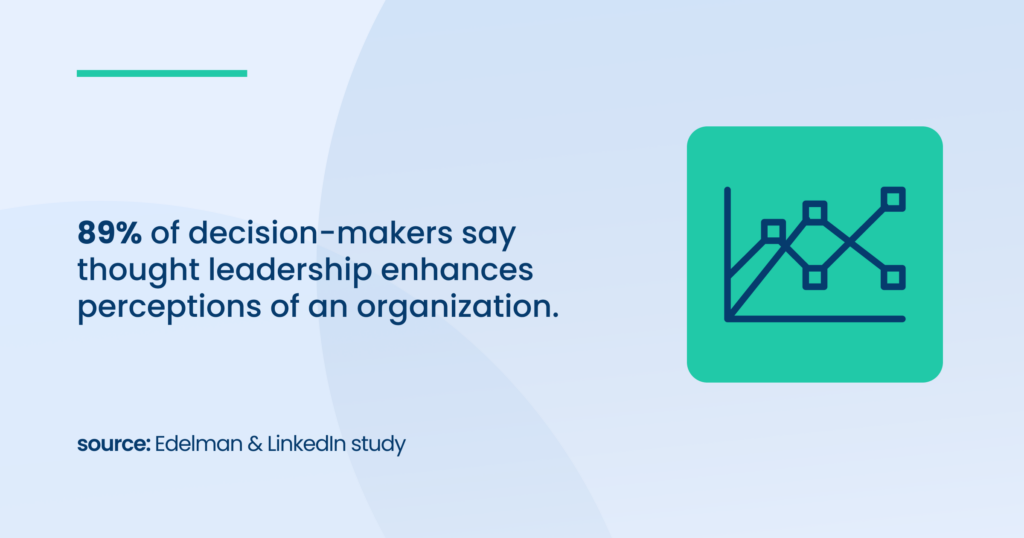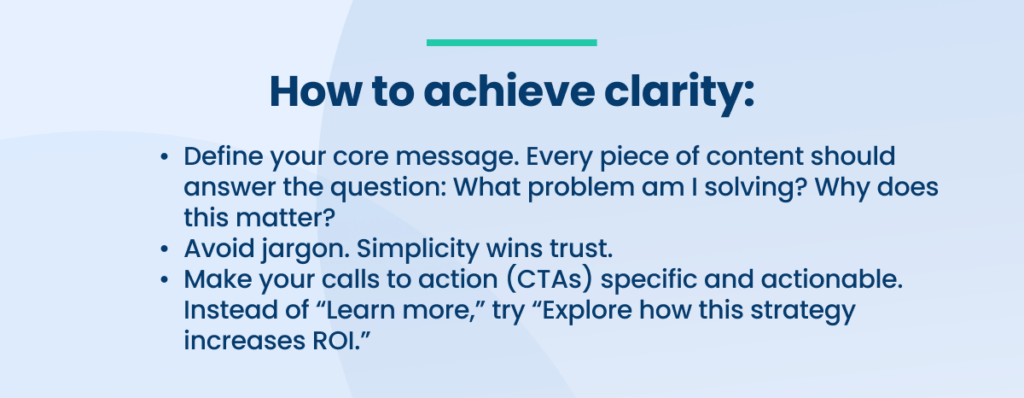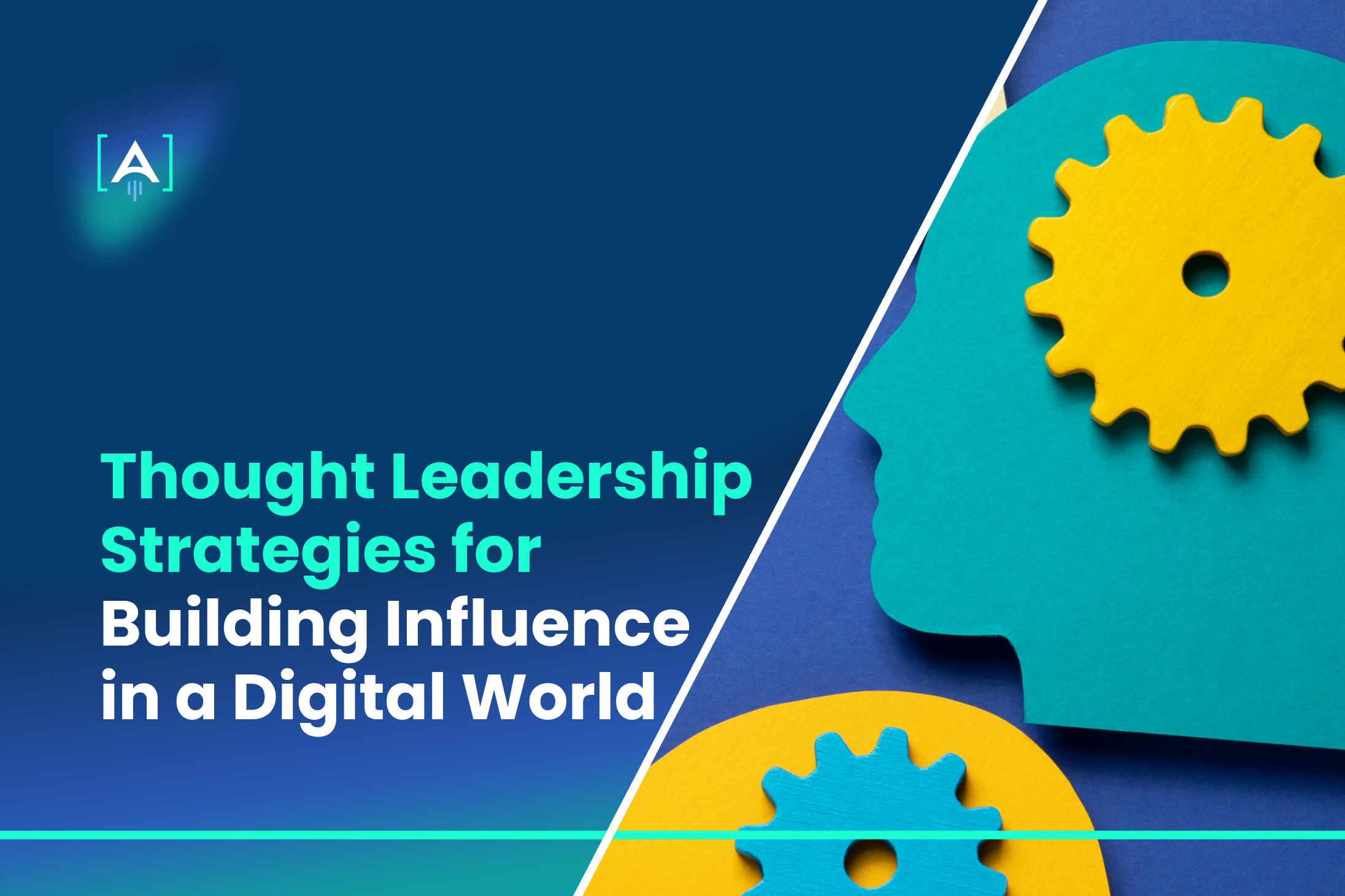The loudest voices don’t always command the most attention—it’s the smartest voices that truly resonate.
Business owners and CEOs are no longer just operations managers. They’re expected to be visionary leaders who inspire trust, spark innovation, and set trends in their industries.
Thought leadership isn’t just about having ideas.
Source: Bright Tail
Another source notes that 65% of buyers say thought leadership significantly changed the perception of a company for the better due to a piece of thought leadership.
A professional Thought Leadership Agency will tap into this potential by guiding you to craft compelling, insightful, and actionable content.
The Blog post will cover the essential Thought Leadership Strategies for Building Influence.
Why Thought Leadership is More Than Just a Buzzword
Influence isn’t bought. It’s earned.
Thought leadership, far from being a trendy term, has become a pivotal strategy for CEOs and business leaders aiming to carve out a lasting impression in competitive markets.
The Shift from Traditional Advertising to Thought Leadership
Traditional advertising was once the go-to method for building influence.
Companies would flood billboards, TV screens, and print media with ads, hoping their messages would stick. But times have changed.
Today, audiences crave authenticity, expertise, and trust. Enter thought leadership—a strategy that allows businesses to connect with their audience on a deeper level.
Unlike traditional ads, which push messages outward, thought leadership pulls audiences in by offering them value. It positions companies as trusted advisors rather than just service providers.
By demonstrating expertise, addressing industry pain points, and offering solutions, thought leadership content fills a gap that advertising often leaves behind: meaningful engagement.
Why Thought Leadership Matters in the Digital Age
The digital world is a noisy one.
With millions of blog posts, videos, and ads competing for attention daily, how do businesses stand out? Thought leadership strategies provide the answer. They allow CEOs and brands to showcase their unique perspectives, effectively cutting through the noise.

The Influence Equation: Combining Expertise, Vision, and Authenticity
Influence isn’t just about having a voice—it’s about how that voice resonates.
Effective thought leadership rests on three foundational pillars: Expertise, Vision, and Authenticity.
When combined, these elements form a compelling equation.
Expertise—The Backbone of Credibility
At the heart of every thought leadership strategy is expertise.
Without a foundation of deep industry knowledge, thought leadership risks being little more than shallow commentary. Expertise establishes your authority, showing that your insights are backed by experience and understanding.
For CEOs, this means demonstrating a mastery of your domain.
Are you well-versed in emerging trends? Can you provide actionable solutions to industry pain points? Expertise isn’t about knowing everything—it’s about positioning yourself as a go-to resource for the most pressing challenges in your field.
- Why is thought leadership important in this context? Decision-makers rely on expert content to guide their strategies. According to Edelman’s report, 55% of B2B buyers use thought leadership to vet potential vendors. Expertise doesn’t just inform—it converts.
Take Indra Nooyi, the former CEO of PepsiCo, as an example. Her deep understanding of consumer behavior and global markets allowed her to implement transformative strategies like sustainable packaging and healthier product lines.
Her insights weren’t just informative—they reshaped the food and beverage industry.
Vision—The Power to Inspire Change
Expertise is crucial, but it’s a vision that elevates a leader from knowledgeable to influential.
Vision is about looking beyond the present to identify opportunities, trends, and innovations that others might overlook. It’s the ability to ask, “What’s next?” and guide your industry toward that future.
Elon Musk exemplifies this pillar with his work at Tesla and SpaceX. His vision isn’t just about electric cars or space exploration—it’s about redefining the future of sustainability and humanity.
By sharing bold goals and revolutionary ideas, Musk inspires not just employees and investors but entire industries to rethink what’s possible.
Incorporating vision into thought leadership strategies also demonstrates foresight, which is a valuable commodity in today’s fast-paced world. CEOs who can articulate where their industry is heading—and how their company fits into that picture—position themselves as indispensable leaders.
Authenticity—The Trust Multiplier
In an era where skepticism runs high, authenticity is the glue that binds expertise and vision together. Audiences crave leaders who are transparent, relatable, and genuine—not polished personas reading from a script.
Source: Stackla
Authenticity means sharing not just your wins but also your struggles, your learning curve, and your humanity.
- Why does authenticity matter? According to a Stackla report, 90% of consumers say authenticity is important when deciding which brands to support. Authentic thought leadership cuts through the noise, creating connections that feel personal and real.
Think about Howard Schultz, the former CEO of Starbucks. His leadership style often included heartfelt stories about growing up in a working-class family and his commitment to treating employees with dignity.
Schultz’s authenticity wasn’t just a PR move—it became a core part of Starbucks’ strategic brand positioning.
Why These Pillars Work Together
Separately, expertise, vision, and authenticity are powerful. Together, they form an unbeatable formula.

From Noise to Noteworthy: Standing Out in a Crowded Digital Space
The digital world is loud—very loud.
With countless brands vying for attention and nearly everyone attempting to establish themselves as a thought leader, it can feel nearly impossible to rise above the noise.
But being “noteworthy” doesn’t require shouting louder; it requires speaking smarter, being different, and delivering value.
Start with Clarity: Make Your Message Undeniably Clear
In a sea of content, clarity is your anchor. If your audience can’t immediately grasp what you’re saying or why it matters to them, they’ll move on.
- Why clarity is non-negotiable: Decision-makers and business leaders—your target audience—don’t have time to decipher convoluted messages.

Clear communication is one of the most critical thought leadership skills—it allows your audience to recognize the value you bring quickly.
Consistency: Build Recognition and Trust Over Time
It’s not enough to post one groundbreaking insight and disappear. Consistency establishes your presence as a reliable authority.
- Why consistency matters: Consistent messaging helps with strategic brand positioning, ensuring your audience knows what to expect from you.
Additionally, platforms like LinkedIn reward consistent posting with better reach and visibility in their algorithms.
- Tips for maintaining consistency:
- Create a content calendar that aligns with your business goals and audience needs.
- Stick to your brand voice across all platforms—whether it’s authoritative, conversational, or motivational.
- Engage regularly. Respond to comments, participate in relevant discussions, and remain visible in your niche.
When you show up consistently, your thought leadership strategies compound, building momentum that keeps you top of mind for your audience.
Offer Unique Perspectives: Be the Expert Who Thinks Differently
Standing out isn’t about copying what others are doing—it’s about offering fresh, actionable insights that challenge conventional thinking.
- How to differentiate your thought leadership strategies:
- Lean into your expertise. Highlight areas where your experience or perspective diverges from industry norms.
- Share types of thought leadership content that aren’t overdone—try visual explainers, live Q&A sessions, or niche webinars.
- Use data-driven insights to back up your ideas. For instance, if you claim new digital PR strategies improve brand awareness, show how it worked for you or your clients.
- Example of standing out: Patagonia’s storytelling doesn’t focus on selling clothes; it emphasizes environmental activism. This shift from traditional branding to purpose-driven messaging has made them a standout thought leader in sustainability.
By consistently presenting ideas others aren’t sharing, you prove your relevance and originality—key thought leadership best practices.
Building Influence Through Content: The Right Formats for the Right Audience
Content isn’t just king—it’s the kingdom.
For business owners and CEOs looking to establish themselves as thought leaders, it isn’t about whether to create content but what kind of content will resonate most with their audience.
Diverse Content Types: Capturing Attention in Every Format
Different people consume content differently.
To truly connect, you need to meet your audience where they are with the formats they prefer.
- Articles: Long-form blog posts or op-eds are foundational for showcasing expertise. They’re perfect for addressing complex industry challenges and demonstrating thought leadership and SEO benefits. For example, a well-optimized article on “Emerging Trends in Sustainable Construction” could boost your site’s ranking while positioning you as a forward-thinker.
- Podcasts: Podcasts offer an intimate, conversational format that busy professionals can consume on the go. CEOs can use this medium to discuss industry trends, share personal insights, or host expert interviews. With 42% of Americans listening to podcasts weekly, this format is a direct line to a dedicated audience.
- Webinars: Webinars provide a live, interactive platform for diving deep into industry-specific topics. They allow thought leaders to connect in real-time, answer questions, and solidify their reputation as problem-solvers.
- Micro-content: Platforms like LinkedIn thrive on short, impactful posts. These are ideal for busy executives who scroll for insights between meetings. A quick, thought-provoking statement or a concise how-to post can spark engagement and amplify your influence.
Matching Content Formats to Audience Preferences
Your content is only as powerful as its ability to reach and resonate.
Understanding your audience’s habits is key to delivering what they need in the way they prefer.
- Busy executives: They value brevity and impact. Short LinkedIn posts, bite-sized infographics, and quick-hitting insights in newsletters are most effective here.
- Mid-level managers: This group often seeks actionable advice. Whitepapers, case studies, and “how-to” webinars can provide them with strategies to apply directly to their work.
- Aspiring professionals: They’re hungry for foundational knowledge and inspiration. Blogs, podcasts, and thought leadership strategies that include career-focused tips are a great way to connect.
Pro Tip: Use analytics tools to track which formats perform best with your audience. This data will help you refine your thought leadership strategy and allocate resources effectively.
Combining Formats for Maximum Impact
No single format can carry your thought leadership strategy on its own.
A mix of content types creates a more comprehensive and engaging experience for your audience.
For instance:
- Start with a blog post outlining your perspective on an industry trend.
- Support it with a podcast episode diving deeper into the topic.
- Create an infographic summarizing key points for social media.
- Host a webinar to answer audience questions and expand on your ideas.
This integrated approach ensures that your message reaches different audience segments in ways they prefer, amplifying your influence across channels.
Making Storytelling Central to Your Content
At the heart of every successful piece of content is a compelling story. Whether it’s a case study showing how your solution transformed a client’s business or a podcast sharing lessons from your entrepreneurial journey, brand storytelling techniques make your ideas relatable and memorable.
- Stories humanize your brand, making it easier for your audience to connect emotionally.
- They simplify complex topics, turning abstract concepts into tangible examples.
When woven into the fabric of your content, storytelling doesn’t just inform—it inspires.
The Psychology of Trust: What Makes Audiences Listen?
Trust has become the currency of influence.
Understanding the psychology of trust is essential for business owners and CEOs striving to build brand authority. It’s not just about presenting data or expertise; it’s about creating genuine connections that inspire loyalty and belief in your leadership.
But what exactly makes audiences listen—and trust?
Source: Nosto
Emotional Connection: The Foundation of Influence
At the heart of trust lies emotion. People don’t just follow numbers or strategies; they follow feelings.
Studies have shown that emotionally charged content is 22 times more likely to be remembered than facts alone. When leaders tap into emotions—whether it’s through empathy, shared values, or inspiring narratives—they create bonds that transcend business transactions.
Imagine a CEO addressing a room of employees. A sterile presentation about quarterly earnings might inform, but a heartfelt story about overcoming adversity with the team inspires. That emotional resonance builds trust, making audiences believe in both the leader and the brand.
Why this matters for CEOs: Emotional connections humanize leadership, turning abstract concepts like “company vision” into something people care about. This is the first step in building brand authority.
Why Relatable, Humanized Leaders Earn Trust
Audiences are drawn to leaders they can relate to.
Research by Edelman’s Trust Barometer reveals that 61% of people trust “someone like themselves” more than an impersonal authority figure. This highlights a crucial shift: audiences no longer respond to distant, untouchable CEOs. They trust those who show vulnerability and humanity.
- The power of relatability: Relatable leaders speak the audience’s language, share their concerns, and reflect their values. When a leader acknowledges challenges or admits mistakes, it doesn’t weaken their position—it strengthens it. Audiences see them as authentic, someone who understands the realities they face.
- How it builds influence: Thought leadership strategies thrive on relatability. Whether through LinkedIn posts, interviews, or speaking engagements, showing the human side of leadership invites trust and loyalty.
Example: Indra Nooyi, former CEO of PepsiCo, often spoke about the challenges of balancing career and family life. This honesty resonated deeply with working professionals, making her a trusted figure beyond her corporate role.
AI and Thought Leadership: Staying Ahead in the Digital Race
AI is no longer a futuristic buzzword—it’s the secret weapon for forward-thinking CEOs and business leaders.
Source: Markets and markets
AI as a Game-Changer for Content Creation
Creating insightful, high-quality content consistently is a challenge.
This is where AI tools like ChatGPT and Jasper come in. They streamline the content creation process, allowing CEOs to focus on strategy while still maintaining a strong voice in their industries.
- ChatGPT: From crafting blog posts to drafting speeches, this AI can generate compelling content tailored to your audience. It helps CEOs articulate complex ideas simply and effectively.
- Jasper: Known for its content optimization, Jasper ensures every piece resonates with your audience. It can help refine tone, style, and clarity, making your thought leadership materials engaging and polished.
Why it matters: Consistent content is a cornerstone of thought leadership. AI helps maintain that consistency without compromising quality.
Why AI Enhances Thought Leadership Strategies
At its core, thought leadership is about staying relevant and authoritative.
AI doesn’t replace your vision or expertise—it amplifies it.
By using AI to streamline content creation, analyze audiences, and enhance engagement, CEOs can focus on what truly matters: shaping the future of their industries.
The Bottom Line: AI Is Your Competitive Advantage
The digital race is accelerating, and AI is the turbo engine that keeps you ahead. From creating impactful content to personalizing audience interactions, it enables CEOs to scale their thought leadership strategies with precision and ease.
By integrating AI into your workflow, you’re not just saving time—you’re crafting a more connected, influential, and visionary leadership style that resonates in a crowded digital world.
Conclusion: Crafting Influence Through Thought Leadership
Thought leadership is more than a strategy—it’s a powerful tool for building influence, trust, and long-term success.
Remember: credibility isn’t built overnight. It results from consistent effort, transparency, and a commitment to providing value. [A] Growth Agency will help you navigate this journey.
Excellence is our standard. We believe in the power of data to inform and drive every strategy, ensuring our actions are as effective as they are innovative.
We combine insight-driven approaches with creative execution, empowering you to become a trusted authority in your industry.
Your success is our mission. Let’s build a thought leadership framework that doesn’t just respond to trends but sets them.

